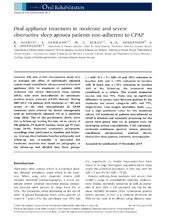| dc.contributor.author | Gjerde, Kjersti | en_US |
| dc.contributor.author | Lehmann, Sverre | en_US |
| dc.contributor.author | Berge, Morten Eirik | en_US |
| dc.contributor.author | Johansson, Ann-Katrin Gerd | en_US |
| dc.contributor.author | Johansson, Anders | en_US |
| dc.date.accessioned | 2016-04-05T11:59:52Z | |
| dc.date.available | 2016-04-05T11:59:52Z | |
| dc.date.issued | 2015-12-27 | |
| dc.Published | Journal of Oral Rehabilitation 2015 | eng |
| dc.identifier.issn | 0305-182X | |
| dc.identifier.uri | https://hdl.handle.net/1956/11846 | |
| dc.description.abstract | The aim of this retrospective study was to evaluate the effect of individually adjusted custom-made mandibular advancement device/oral appliance (OA) in treatment of patients with moderate and severe obstructive sleep apnoea (OSA), who were non-adherent to continuous positive airway pressure (CPAP) therapy. During 2007-2013, 116 patients with moderate (n = 82) and severe (n = 34) OSA non-adherent to CPAP treatment were referred for dental management with an individually adjusted OA at a specialist sleep clinic. Ten of the participants (8·6%) were lost to follow-up, leaving the data set to consist of 106 patients (71 men/35 women, mean age 57 year, range 28-90). Nocturnal respiratory polygraphic recordings were performed at baseline and follow-up. Average time between baseline polygraphy and follow-up was 12 months. A successful OA treatment outcome was based on polygraphy at the follow-up and divided into three groups: 1 = AHI <5; 2 = 5 ≤ AHI <10 and >50% reduction in baseline AHI; and 3. >50% reduction in baseline AHI. If there was a ≤ 50% reduction in baseline AHI at the follow-up, the treatment was considered as a failure. The overall treatment success rate was 75%. There was no significant difference in success rates between patients in the moderate and severe categories (69% and 77%, respectively). Low oxygen saturation (SpO2 nadir) had a high predictive value for OA treatment failure. OA treatment of patients non-adherent to CPAP is efficient and especially promising for the severe OSA group who are at greatest risks for developing serious comorbidities, if left untreated. | en_US |
| dc.language.iso | eng | eng |
| dc.publisher | Wiley | eng |
| dc.rights | Attribution CC BY-NC | eng |
| dc.rights.uri | http://creativecommons.org/licenses/by-nc/4.0/ | eng |
| dc.subject | continuous positive airway pressure | eng |
| dc.subject | mandibular advancement | eng |
| dc.subject | medical device | eng |
| dc.subject | obstructive sleep apnoea | eng |
| dc.subject | oximetry | eng |
| dc.subject | somnography | eng |
| dc.title | Oral appliance treatment in moderate and severe obstructive sleep apnoea patients non-adherent to CPAP | en_US |
| dc.type | Peer reviewed | |
| dc.type | Journal article | |
| dc.date.updated | 2016-02-04T12:15:35Z | |
| dc.description.version | publishedVersion | en_US |
| dc.rights.holder | Copyright 2015 the authors | |
| dc.identifier.doi | https://doi.org/10.1111/joor.12376 | |
| dc.identifier.cristin | 1305315 | |

